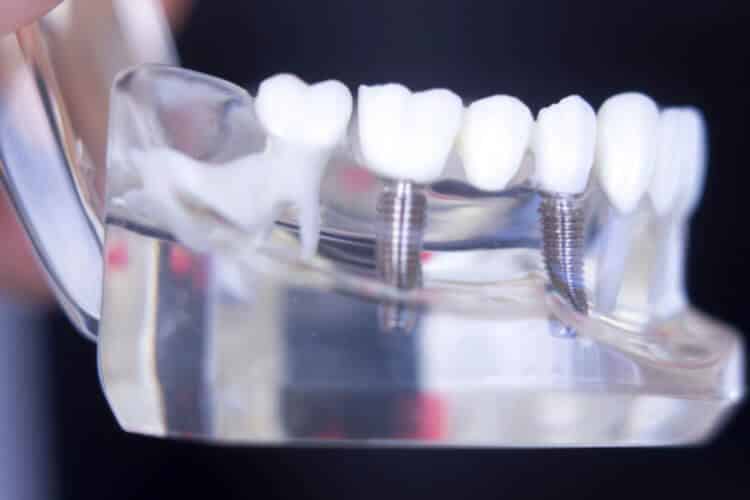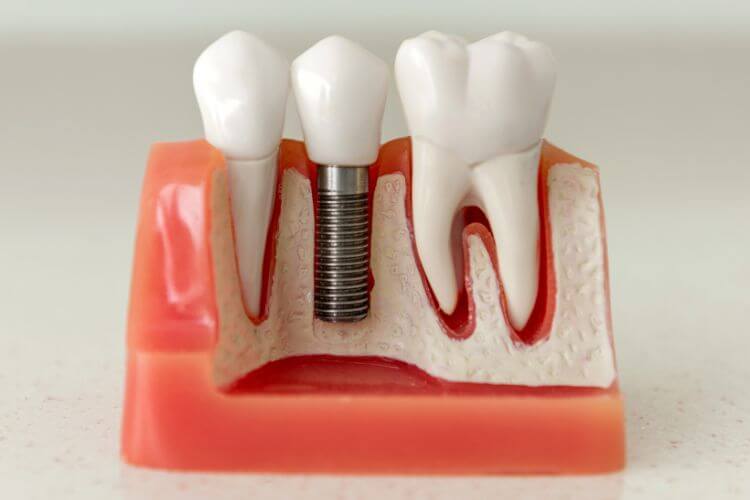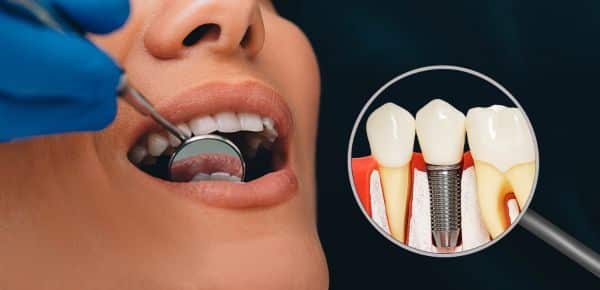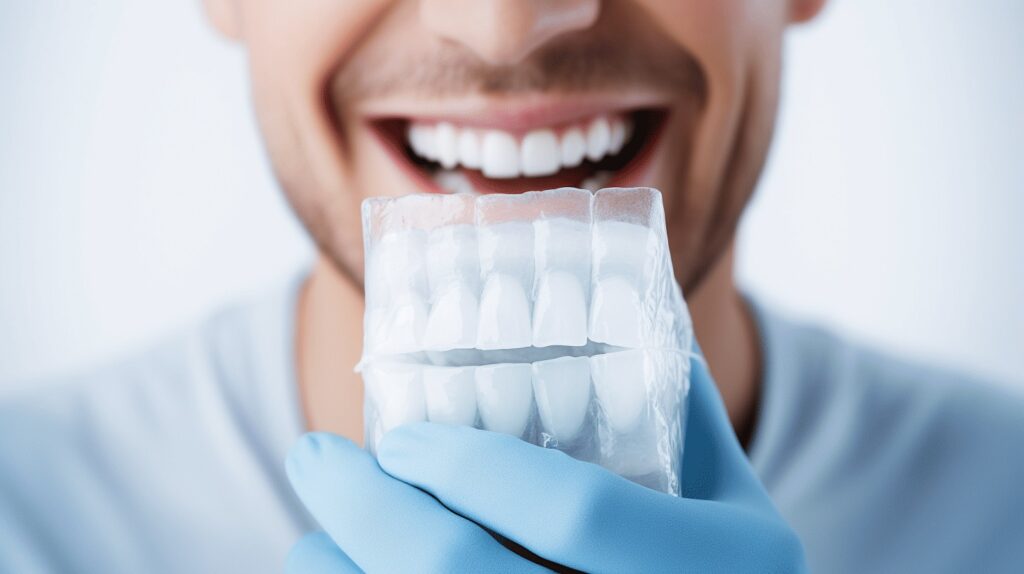As the world keeps spinning, technology keeps advancing, and in leaps and bounds.
One avenue enjoying the leaps? Dental science! Here, we’ll take you on a trip exploring one of the remarkable milestones of this enterprise – dental implants.
We’ve all known someone who’s lost a tooth or two (or maybe it was even us!). A damaged smile can be an uncomfortable experience, both physically and emotionally. But thanks to tremendous advancements in dental implant technology in recent years, those spaces in your smile can now be empty no more.
In this article, we’ll whisk you through the evolution of dental implants, the latest technological innovations in the field, perfect materials for the job, and the exciting future of dental implants. So hold on to your molars; we’re in for one fascinating teeth-tale! 😁🦷
This textbook written by us is your compass through the transformations that have taken place, and are continuing to transpire, in the field of dental implantology. Buckle up! Dull moments will be in short supply.
Table of Contents
Evolution of Dental Implants
Dental implants have undergone a fascinating metamorphosis throughout history.
They are proof of constant human innovation and the persistent pursuit of improved oral health. The evolution of dental implants isn’t just about technological advancements; it’s about a more profound understanding of biology and the intricate interplay between the human body and medical devices.
Let’s delve into this captivating journey through time, exploring the early developments and appreciating their current state.
Early Developments
Our journey into the past takes us back to the 1950s, a period of significant scientific discovery.
Dental implants, as we know them today, had very humble beginnings. The transformation started with a serendipitous discovery by Per-Ingvar Brånemark, a Swedish orthopedic surgeon. He observed that titanium fused naturally with bone tissue, a process he called osseointegration, opening a new horizon for tooth replacement treatments.
The first dental implants were rudimentary, utilizing simple materials and designs. Yet, their success laid the groundwork for future advancements. Here are a few key points:
- First use of titanium: The adoption of titanium in dental implants marked a significant step forward. The metal’s natural compatibility with the human body made it the perfect choice. Its adoption brought about better success rates, safety, and durability.
- Evolution of implant designs: From one-stage to two-stage surgeries, the designs evolved, aiming to reduce trauma, improve outcomes, and shorten recovery time.
Current State
Leapfrogging into the present day, dental implants have become a mainstream solution for replacing missing teeth.
Technological strides combined with a refined understanding of dental and human physiology have revolutionized the field. Modern dental implant procedures are swift, safe, and have impressive long-term success rates. They’ve truly transformed millions of smiles worldwide.
The exciting part is that with every stride in technology, dental implants continue to become more reliable, cost-effective, and accessible. Notably, Computer-guided implant surgeries, use of zirconia implants, and advancements in 3D imaging have truly raised the bar.
With every new technique and discovery, we are steadily breaking down barriers to good oral health. We’ve traversed a fascinating timeline from primitive beginnings to an age of unbounding possibilities. And, if the current state is any indication, the future of dental implants will continue to dazzle, shining brightly with more breakthroughs, sophistication, and inclusivity.
Because remember, a smile isn’t just a curve that sets everything straight; it’s a universal sign of happiness — and we believe everyone deserves to wear it proudly.
Technological Innovations in Dental Implants
Modern dentistry is undergoing an exciting transformation, thanks to the remarkable leaps in technology.
We’re moving away from the traditional ‘drill and fill’ methods and embracing more innovative techniques, especially in the field of dental implants.
Let’s explore three top technological advancements that are revolutionizing the dental implant industry right now: digital imaging and planning, guided surgery, and computer-aided design and manufacturing (CAD/CAM).
Digital Imaging and Planning
Navigating the world of dental implants has been made infinitely easier by digital imaging and planning technologies.
🖥️ These tools provide a clear and accurate visualization of the patient’s oral anatomy, taking the guesswork out of implant placement.
Here’s how they’re making a difference:
- Improved accuracy: This technology captures every intricate detail of the patient’s oral structure, leading to more precise implant planning.
- Enhanced success rates: Thanks to the detailed imagery, dental professionals can anticipate potential complications and devise strategies to mitigate them, thereby increasing the success rates of dental implant procedures.
Guided Surgery
When it comes to implant surgery, precision is paramount. And guided surgery techniques are leading the way in achieving this precision.
🎯 These techniques use digital planning data to guide the surgeon’s hand during the implant procedure. Essentially, it’s like having a high-tech GPS for dental implants!
Benefits of guided surgery:
- High-accuracy placement: With the assistance of these tools, dental implants can be placed exactly where they were planned.
- Streamlined procedures: Guided surgery increases efficiency, reducing the time taken for the procedure and enhancing the patient’s comfort.
Computer-Aided Design and Manufacturing (CAD/CAM)
Picture this: a dental implant customized entirely to fit your unique oral structure. Sounds like science fiction, right? Nope, it’s here and now, thanks to computer-aided design and manufacturing systems.
🦷 These systems use digital scans to create a 3D model of your mouth, which is then used to design and manufacture customized implant components.
Key advantages of CAD/CAM systems:
- Tailor-made implants: These systems allow for the creation of highly individualized implant components, promising a better fit and a more natural feel.
- Faster turnarounds: CAD/CAM technology reduces the manufacturing time of dental implant components, speeding up the overall dental implant journey.
So there you have it! Today, if you need a dental implant, you can be assured you’re benefiting from some stunning technological advancements.
These innovations are not only transforming smile restorations, but they’re making the journey smoother, faster, and more comfortable than ever before.
Now that’s something to smile about! 😊
Biocompatible Materials for Dental Implants
Looking for the golden ticket to a gleaming, healthy smile? Dental implants might just be your answer.
But before you picture yourself in a dentist’s chair, let’s delve into the materials that make dental implants a reality.
Ever heard of titanium or zirconia? We bet you have! These biocompatible materials are rockstars in the dental implant world and for a good reason.
Titanium and Titanium Alloys
Titanium, yes, the very same metal used in aircrafts and missiles. But get this: your body loves it! Being a biocompatible material, it’s well tolerated by the body and shows minimal rejection.
Here are some strong points about titanium:
- It’s super strong. Titanium and its alloys provide a winning combo of strength and lightness. This means your implants are long-lived, hardy friends.
- It’s corrosion-resistant. They don’t rust or deteriorate like other metals can.
- It’s biocompatible. Your body receives titanium implants like a long-lost friend, making the healing process smoother.
Titanium and titanium alloys are widely used for dental implants due to their excellent biocompatibility and strength.
Back in the day, there were concerns about the metallic look of titanium dental implants. These days those are things of the past with most titanium implants being covered up by the new growth of natural teeth and gums.
Zirconia
All aboard the zirconia train. This material has been making quite the entrance in the world of dental implants.
Advantages of zirconia include:
- It’s tooth-colored. For those who are after a natural look, zirconia implants do the trick beautifully.
- It could be more durable. Some studies suggest that zirconia may be equal to or potentially even more durable than titanium.
Zirconia implants have gained popularity for their natural appearance and potential durability.
So there you have it! Whether it’s titanium’s strength and biocompatibility or zirconia’s natural appearance that swings your vote, rest assured that both materials promise a future of bright smiles and generally uncomplicated toothy affairs.
However, before you lock in your choice, it’s always important to discuss your personal situation and needs with your dentist. Here’s to taking a bite out of life – with confidence and a beaming smile!
Enhancements in Implant Surface Technology
When it comes to the world of dental and orthopedic implants, one cannot overlook the vital role that implant surface technology plays.
It’s a fascinating area that continues to evolve, delivering robust and reliable solutions for patients who require such treatments.
The advancements we’re seeing in this sector are primarily aimed at promoting better osseointegration, leading to improved implant stability and long-term success. 🚀
Osseointegration
Osseointegration, in simple words, is the process whereby a foreign object, primarily made of titanium like a dental or orthopedic implant, integrates with the native bone tissue.
It’s an essential factor in determining the success rate of an implant. The better the osseointegration, the more stable and serviceable the implant is.
- Improved implant surface technology directly aids in enhancing this osseointegration.
- Certain developments, such as nanoscale surface modifications, have shown to significantly increase the speed and strength of osseointegration.
Surface Modifications
Let’s get a bit more technical now. How exactly is implant surface technology improving to foster such successful osseointegration?
The key lies in specialized surface modifications.
- We’ve seen the advent of nanotopography, an intricate method of developing surfaces at a nanoscale level to closely mimic the natural bone structure. This modification enhances the interaction between the implant and surrounding bone tissue, encouraging greater osseointegration. Microscopic bumps and grooves on the implant surface give the bone something to ‘grab onto,’ facilitating a more secure integration.
- The application of bioactive coatings is another breakthrough that’s proving to be a game-changer. These coatings encourage bone growth around the implant, reinforcing its stability over time. The coatings work by releasing bioactive substances that stimulate bone formation, augmenting the implant’s longevity and performance.
“The advancements in implant surface technology are making dental and orthopedic implants more efficient, reliable, and durable. The future of this technology is indeed promising.”
In essence, the enhancements in implant surface technology are revolutionizing dental and orthopedic treatments.
By improving osseointegration and leveraging innovative surface modifications, implants are becoming more efficient, reliable, and durable.
Hold tight, as the future of this technology is indeed promising! 💪🔬
Regenerative Approaches for Dental Implants
Jaw-dropping advances in dental implant technology make it now possible not just to replace, but also regenerate lost tissues in the mouth. Exciting, isn’t it?
This revolutionary approach involves driving your body’s own healing processes into overdrive, facilitating tissue regeneration, and ensuring stronger, long-lasting implants.
Let’s dive in and explore two popular regenerative strategies: guided bone regeneration (GBR) and platelet-rich plasma (PRP) therapy.
Guided Bone Regeneration
“A smile is a curve that sets everything straight”, a popular adage goes.
🌟 Well, GBR could be the secret to that perfect curve. It’s a therapeutic technique primarily used to enhance the quality of the implant site.
But how does it work?
GBR uses a barrier membrane positioned over a bone defect, launching the regeneration process. The membrane allows bone-forming cells to populate the defect area and create new bone. The outcome? A superb-quality site ready to host your implant.
Here are a few key benefits of the GBR treatment:
- Stimulates bone growth 💪
- Improves the quality of the implant site 🎯
- Increases the longevity and stability of the implant 👌
Platelet-Rich Plasma
Next up, we have Platelet-Rich Plasma (PRP) therapy. The name sounds quite scientific, but the concept is simple yet powerful.
PRP therapy harnesses the power of your own blood platelets to accelerate the healing process, leading to successful dental implant placement.
In PRP therapy, a small amount of your blood is spun rapidly in a centrifuge to separate the plasma. This plasma, rich in platelets and growth factors, is then applied to the surgical site.
The result? Rapid tissue healing and regeneration. 🏥
Key benefits of PRP treatment include:
- Accelerates healing process 🚀
- Promotes tissue regeneration 💡
- Enhances implant success rate 🎊
Shifting to regenerative approaches like GBR and PRP can revolutionize dental implant technology, offer superior healing, and provide sturdy, long-lasting implants. Extend your smile with confidence, knowing the science of regeneration has got your back, or rather, your teeth! 😄
Remember, the best self is a healthy self, so what better way to invest in you than to prioritize your dental health?
Embrace the innovative changes in dental implant techniques and say goodbye to oral health issues for good! Deciding to smile shouldn’t be a tough choice. 😊
Improved Implant Success Rates and Longevity
As we witness the scaling heights of technology and continuous research, we can definitely say that dental health is among the beneficiaries of these advancements.
The revolution in dental implant technology and procedures has immensely contributed to higher success rates and increased longevity of dental implants. But what does this really mean for us, and why does it even matter? 🤔
For starters, dental implants are a much-preferred solution for replacing lost teeth. They don’t just help in improving your smile, but also retain the original structure of your jawbone, maintain facial harmony, and even enhance your overall quality of life.
But the one thing that could discourage anyone from opting for dental implants could be the concern regarding their success rate and longevity.
There are a few key factors that have largely influenced these improved outcomes:
- Innovative Technology: 💡 Advancements like computerized tomography (CT) scans and 3D dental implant planning software have increased the precision in implant placement thereby contributing to improved success rates.
- Improved Materials: The new-age implant materials like titanium and ceramics have combined durability with biocompatibility, ensuring that the implants not just mimic the functionality of natural teeth but also last long without causing any side effects.
- Skilled Professionals: 🦷 The increasing success rates of dental implants can also be attributed to well-trained and experienced dental surgeons, who ensure the least invasive procedures are used, hence promoting faster recovery and long-term success of the process.
We definitely can’t ignore how dental implants have evolved over the years, and how an amalgamation of improved technology, materials, and skill have contributed to this evolution.
Today, we’re looking at dental implants with an impressive track record – a success rate of over 95% recorded in multiple studies, and the possibility of implants lasting a lifetime with proper care!
So, should you consider dental implants? Yes, because they’re not just about replacing those missing teeth. They’re about restoring your confidence, improving your health, and enhancing your looks for years to come.
And guess what? With the progressing dental technologies and capabilities, we can only foresee the success rates going higher.
So, it’s goodbye tooth loss and hello perfect smile! 😁
Future Trends and Research in Dental Implants
The world of dental implants has seen significant technical advancements and research breakthroughs over the years that challenge the typical notion of ‘filling gaps’ in smiles.
With the emergence of groundbreaking technological trends like nanotechnology and tissue engineering, we’ve only scratched the surface of what’s possible in the field of dental implantology.
We’d like to take you on a journey across these promising developments, shedding light on how they might reshape the future of dental care and bring about better outcomes for patients globally.
Nanotechnology
Nanotechnology is bringing about revolutionary possibilities in enhancing the quality of dental implant materials and their surface properties.
It’s easy to understate the importance of this, but bear with us as we emphasize why it’s crucial.
- First and foremost, dental implant materials have to be compatible with the body to avoid any adverse reactions. The use of nanotechnology can dramatically improve this biocompatibility through precise manipulations at the atomic level, reducing potential health risks.
- Not to mention, the implant’s surface properties play a pivotal role in its ultimate success. A nano-engineered surface can offer improved interaction with surrounding bone and soft tissues, leading to faster and more efficient healing.
- Furthermore, nano-coatings provide a promising avenue for enhanced resistance to infection. With their inherent antimicrobial properties, they can create a hostile environment for bacterial colonies trying to set up shop on the implant, a common problem in dental surgeries.
While nanotechnology in dental implants is still in the developmental stage, research indicates that the potential benefits are too significant to overlook.
Indeed, dental implantology stands to gain immensely from this small but mighty technology.
Tissue Engineering
While nanotechnology creates better materials for implants, tissue engineering takes a bold step forward, proposing an approach that could potentially regenerate entire tooth structures.
We’re talking about custom-made teeth, folks – ones that are grown from your own cells and perfectly fitted.
- The core concept of tissue engineering revolves around the body’s capacity to grow new tissue. By using a combination of cells, supportive scaffolding, and growth factors, this approach aims to stimulate your body to regenerate a completely new tooth.
- The potential of this technology could herald a new era in dental care, providing patients with a natural, functional tooth replacement, and circumventing the traditional implants that may sometimes fall short in terms of comfort and aesthetics.
Tissue engineering, though still to find its firm footing in practical applications, places dental research at an exciting crossroad, transforming the way we view the potential of the human body for natural regeneration.
Transformations like nanotechnology and tissue engineering reflect the potential that future dental implantology holds.
It’s a thrilling time to witness such innovation, where individual smiles can be restored not just physically, but naturally and more efficiently.
The combination of these trends amplifies the significance of research and development within dental science, setting an inspiring course for the future of dental health.
Conclusion
It’s truly fascinating to see how far the field of dental implants has come and the cutting-edge technologies currently shaping its future.
Yes, the journey of dental implants from early developments to current state-of-the-art techniques has been a great leap, but it doesn’t end there. Innovations in digital imaging, guided surgery, and computer-aided design are continuously enhancing patient outcomes.
Equally impressive are advancements in biocompatible materials and implant surface technology, promising longevity and successful integration with the human body.
The advent of regenerative approaches, such as guided bone regeneration and platelet-rich plasma, enables promising strategies for handling challenging cases. We foresee nanotechnology and tissue engineering further improving the field’s landscape, driven by relentless research efforts globally.
At Wilshire Smile Studio, we are proud to participate in this incredible journey, providing outstanding dental implant services leveraging these advancements. Driven by our commitment to offer the best care to our patients, we combine our exceptional expertise with these pioneering techniques for optimal results.
Your journey towards a dazzling smile begins with a simple step.
Call us at (323) DEN-TIST (336-8478) or book an appointment online for a free consultation at Wilshire Smile Studio.
The perfect smile of your dreams might just be a dental implant away! 😊 🦷
Frequently Asked Questions
1. What are the advancements in dental implants expected in 2023?
In 2023, advancements in dental implants are expected to include improved implant materials, such as zirconia and titanium alloys, enhanced implant design for better stability and integration, and the use of computer-guided implant placement techniques.
2. Are dental implants a safe and reliable option for tooth replacement?
Yes, dental implants are considered a safe and reliable option for tooth replacement. They have a high success rate and can last a lifetime with proper care and maintenance.
3. What are the benefits of dental implants compared to other tooth replacement options?
Dental implants offer several benefits over other tooth replacement options, including improved aesthetics, functionality, and comfort. They also help preserve bone structure, prevent facial sagging, and allow for normal speech and eating.
4. Is the dental implant procedure painful?
The dental implant procedure is generally performed under local anesthesia, so you won’t feel any pain during the surgery. After the procedure, there may be some discomfort, which can be managed with pain medication prescribed by your dentist.
5. How long does the dental implant process take from start to finish?
The dental implant process can vary depending on individual cases, but it typically takes several months to complete. This includes the initial consultation, implant placement surgery, healing period, and the placement of the final dental crown or prosthetic.









